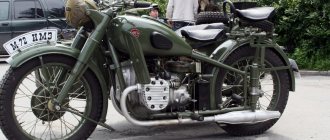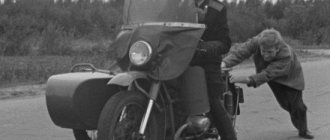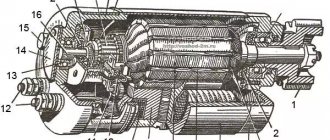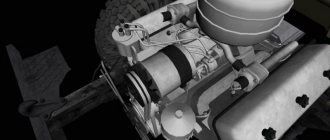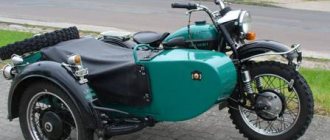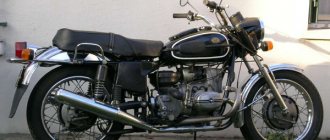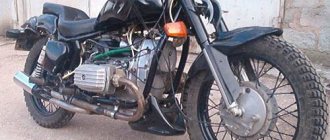Motorcycle URAL - owner reviews
Helgi Apfelwein
https://irecommend.ru/content/isklyuchitelno-dlya-predannykh-fanatikov
Designed exclusively for fanatics
Advantages:
warmth and storm of emotions, even today!
Flaws:
- unreliable
- increased fuel consumption
I've been with motorcycles since I was 13 years old. I started with small and weak mopeds. Gradually he switched to more powerful and expensive Japanese motorcycles. But this is now.
In those distant times, all the boys raved about the motorcycle theme. I had to get rid of my father's or grandfather's trash.
After graduating from college, I bought myself a Ural motorcycle. It was a joy beyond description.
Everyone has their own attitude towards the Urals. I have it in two ways. The motorcycle made a certain contribution to my development.
Firstly, this is a really powerful and heavy motorcycle. It can be used for its intended purpose, for utilitarian needs. It has serious cross-country ability and is undemanding to maintenance.
But many people unhook the stroller and drive this heavy apparatus at full speed, forgetting about caution.
Now, after many years, I am no longer so enthusiastic about this device. Most of his positive qualities are the fan factor. A motorcycle supported only by emotions. This is because in those days nothing else could be bought. And now no one buys Urals for rides, because any cheap Chinese motorcycle will be ten times better and more economical and reliable.
Unfortunately, myths about the indestructibility of the Urals are born by those who did not repair it. My Ural required constant repairs. And all my friends also have the same situation. The oil was constantly leaking, the seals did not hold. The nuts were unscrewed. The cables were breaking. But of course it remained on the move, because half of the repairs could be done in the fields using wire and duct tape.
But the Urals made us real mechanics. We could disassemble and assemble it almost with our eyes closed. Modern motorcycles do not break down and therefore they do not provide such childish delight from learning all the “hardships of maintenance”.
Nowadays a lot of Urals are sold abroad, but these are not the same motorcycles, half of them are made from imported parts, so they are very reliable and very expensive. It is wrong to compare them to the same ones as before. Our Urals were heavy, uncontrollable and fuel-guzzling like tractors.
The Ural was not bad for driving around the village; in a pinch, you could always tow it home. But those brave souls who went on a trip on it took with them bags and boxes of spare parts and fasteners.
I went on a short trip twice in my Urals and something constantly broke down. But for the sake of fairness, I’ll say it was easy to repair and the spare parts are cheap and are sold to every general store.
Now I ride a Japanese touring motorcycle. Unfortunately, I don’t have as much time for repairs and maintenance of equipment as in those years. But the Japanese break down very rarely. I can’t imagine that it would occur to me now to go somewhere on a trip to the Urals. Perhaps to the neighboring area.
I gave my Ural to my neighbor in the garage, he might make some kind of project out of it. For projects and renovations, the Urals are simply ideal.
And if you want to ride and not learn how to repair, buy a small-capacity Japanese motorcycle and travel across the whole country without problems, nothing will happen to the motorcycle.
I Ural should be stored in the garage and wiped with a cloth, remembering past years!
Alex
https://citykey.net/review/ustarevshiy
Advantages:
- powerful
Flaws:
- his time has passed
In my childhood, when cars cost a lot of money and only the “elite” of society could buy them. But my family was not one of those people; we used a Soviet-made Ural motorcycle. It was equipped with a cradle, which allowed it to transport up to 4 people. In general, the motorcycle was very good, powerful, and started up with a bang at any time of the year. Although there were breakdowns, what could we do without them? After all, if you actively use it, something will fail. Therefore, they simply did not pay attention to the breakdowns. Due to its high power and weight, this motorcycle consumes a decent amount of gasoline. Therefore, it is considered not entirely economical among motorcycles.
We drove it mainly to the apiary, which was located very far away, 80-200 km, exactly at that interval, because the apiary was located in different places. The road is most often not paved but a country road, but what’s strange is that after the rain I don’t remember even once that we skidded or got stuck somewhere. Apparently this simply did not happen. Although it is very outdated, I mean the brand, now such motorcycles are not held in high esteem, but still I have very warm memories of it. Even now I’m thinking about buying an old Ural and repairing it and tuning it, but it’s a rare manufacturer’s company. After all, not everyone can boast that they race in the Urals, but I can. Therefore, I give this motorcycle a solid four.
TheOliver
https://otzovik.com/review_172779.html
Advantages:
- Cross-country ability like a tank
- availability of spare parts
- phenomenal maintainability
Flaws:
- Unpredictability in breakdowns
- low speed
- outdated design
I have been dealing with the Urals for a long time and only recently stopped dealing with them. But more on that later. As a wheelchair user, I have no complaints about it; rarely do wheelchair drivers use it too harshly. I was dealing with a single custom car, which I drove quite a lot. First of all, a few words about the design. But it remained at the level of the 40s and remained there. Modern Urals are simply “touched up” without improving them technically at all. For example, it is very difficult to remove the crankshaft from the crankcase, but this is a military motorcycle! In war conditions, delay was like death. So five-speed gearboxes were left behind in evolution. In order to make a normal single from the “standard” it is necessary, first of all, to replace the rubber bushings of the rear pendulum with bearings or caprolon bushings. The lack of such a replacement cost me a broken leg. It is necessary to replace the wheels with smaller diameter ones. Installation of traverses with rigid fixation of stays, front disc brake. It is advisable to install a more powerful generator, at least the same Japanese Denso. For long and trouble-free operation, it is necessary to replace almost EVERYTHING with automotive or imported ones - oil seals, bearings, forged pistons, etc. To reduce fuel consumption, it is necessary to install imported carburetors. From my personal experience, I will say that the motorcycle is very capricious and absolutely anything can fly out, completely unpredictably. This, of course, is compensated by the low cost of spare parts and their availability in almost any locality in Russia. But the end of my trips in the Urals was set by one incident when I was driving with my girlfriend along the highway at a speed of about 100-110 (and for me this is the ideal cruising speed), and I heard a loud crash and a sharp drop in power. I looked down and what do you think I saw? A completely severed cylinder hanging from the exhaust elbow and carburetor cable. I can’t imagine how it didn’t jam at the same time. When I stopped, I was even more surprised. The cylinder was not torn out along with the studs, but simply torn away from these same studs. The piston and pin clearly remained somewhere on the track, because we never found them. But that's not all. The upper connecting rod hole acquired an oval shape, as well as the connecting rod itself bent by 30 degrees. The metal oil channels in the crankcase were also bent. Since then, I decided to give up 650 cc Urals forever and installed an engine from the Dnepr, incomparably more powerful, smoother, and less capricious.
Tarasoffvas
https://otzovik.com/review_4061052.html
Advantages:
- Quite a cheap motorcycle.
Flaws:
- Gearbox and engine speed.
"Ural" was one of the first motorcycles. Actually, I learned to ride on it.
In principle, for a first motorcycle and for a sufficient period of use, this is what you need.
One of the advantages of this motorcycle: the presence of reverse gear.
There are no breakdowns every other day, as happens with other motorcycles. Of course, a lot, almost everything depends on the care of the motorcycle and how you ride.
On the Ural base, motorcycle enthusiasts very often make modifications, or even trikes in general. Because the design of the motorcycle allows.
There are, of course, a number of disadvantages: many people complain about the gearbox, saying it breaks quickly. Also, the motorcycle is quite revvy, which is not very good when driving on the ground, after rain, because the rear wheel digs into the ground.
General impression:
The impressions are not clear.
Lan, don't growl
https://fishki.net/auto/2087042-pochemu-motocikly-ural-tak-populjarny-v-amerike.html
Today it is easier to find Ural motorcycles somewhere in Florida than near Kaluga. The explanation is simple: the Irbit motorcycle plant, which with difficulty, but still survived the difficult 90s, continues to operate, but now exports nine-tenths of its products. Mostly overseas.
There is demand. And this is taking into account the fact that in America a “Ural”, or rather a Ural, with a sidecar can be purchased for about $15,000. For reference: in the USA they ask for the same amount for a brand new Harley-Davidson of the classic Softail family in the basic version.
The reason is simple - retro fashion. “Yes, Harley is no longer the same,” orthodox American bikers mutter through their mustaches and increasingly look at the Russian Military Motorcycle, as our “Urals” are called overseas. This interest is cleverly fueled by marketers who constantly repeat that he is truly Russian and undoubtedly military. Straight from the battlefields of World War II, virtually unchanged, straight to your garage. As proof, commercials are shown - there are many of them on the Internet - with bravura marches and historical newsreels, where soldiers, bristling with machine guns, ride in orderly columns on motorcycles with sidecars...
Antique
https://otzyvy-otritsatelnye.ru/otzyvy/tovary-i-uslugi/avtomobili/39808-otzyvy-o-motocikle-ural.html
Ural is my dream
Indeed, I dreamed about this legendary motorcycle from the moment I rode it as a boy, I really liked the speed and drive of racing on this iron horse. But when I found out how many little things and subtleties there were in its repair, and by the way they broke down no less often than cars, I realized that this was not for me. I don’t like to tinker with technology and that’s all, I prefer the process of driving. Of course, cars are different, but my heart probably lies more with them.
But overall, I want to say that we can be proud that we had and still have such a wonderful manufacturer of motorcycles, and even though now they are not so in demand. I will still respect the designers and those people who, one might say, made our dream come true. What I have always respected them for is that they seem to have found out the ideal formula for creating a motorcycle and brought it to life. Everything seems to be in its place, and the handling is good, the engine and brakes are all in such a beautiful body style.
Of course, the Ural can no longer be equal to modern powerful beasts from Honda and others. But it will be remembered for many years by those people who rode it at least once and felt the freedom that someone feels every day on it.
Wickering
Advantages:
- convenient to transport cargo
- good maneuverability
Flaws:
- Breaks too often.
Details:
About 10 years ago I bought a Ural motorcycle. When I bought it, I didn’t even think how much fuss there would be with this motorcycle. I already bought it secondhand for only 5 thousand. The first summer seemed to go well, at the very least. But the next summer began. First the capacitor burned out, then a week later the tank broke. Another year later the mufflers had to be changed. I’m generally silent about the speedometer, they immediately flew off (I never found why they didn’t work, it seemed like all the wires were in good order). And then, to complete the happiness, the frame also broke. I will also say that the gearbox is not stable and reliable. Roughly speaking, I invested 30-40 thousand on this motorcycle over 5 years. This is only for repairs. And it consumes gasoline... 25-30 liters. There was a cradle, it was convenient to transport all sorts of cargo. There was also a reverse gear, but unfortunately it didn’t work when I bought it. So draw your own conclusion whether you need such a motorcycle or not...
MY MOTORCYCLE
Urals - these motorcycles will roam the expanses of our homeland for a long time. By the way, in the USA, new Urals models are quite popular and in demand. And it won’t be long before their place is taken by a new generation of equipment, some who don’t have enough money, some who love them very much, etc. This article is so that you know what to look for when buying a motorcycle, regardless of whether it is new or not.
So the long-awaited “Ural” stands in front of its happy owner: long-time dreams of a new motorcycle have come true. The battery is charged and connected, gasoline is poured into the tank. The motorcyclist turns the ignition key, pumps gasoline into the carburetors, confidently presses the growl of the starting mechanism - the engine starts immediately. But what is this... An unpleasant screeching sound suddenly appears and grows threateningly in the front part. “Everything is clear - a factory defect,” concludes an inexperienced motorist. In fact, the reason lies in your own inexperience or outright negligence when handling a motorcycle. Therefore, let us dwell in more detail on those “pitfalls” that await new motorcyclists.
The malfunction that we took as an example is one of the most common and has the specific name “breather stuck.” Rotating in the central hole of the timing gear cover, the breather connects the engine crankcase to the atmosphere when the pistons move to BDC and, conversely, isolates it from the atmosphere when the pistons move and top dead center. The gap between the rotating breather and the cover is very small. When the engine is running, oil mist forms in the crankcase, which lubricates the breather. However, during long-term storage of the motorcycle, as well as during long periods of non-use, oil flows from the gap into the crankcase. When traveling short distances, the engine oil does not have time to warm up properly, and oil mist does not form. Consequently, the breather in this case is not lubricated or is poorly lubricated. After starting the engine, it “rubs” dry in the hole of the cover, and the aluminum from which the cover is made envelops the breather. As a result, serious engine repairs will then be required. Meanwhile, it is very easy to avoid this. Before starting an engine that has not been running for a long time, you need to use a rubber tube with a bulb to inject a little oil used to lubricate the engine into the breather channel - that’s all.
Especially do not neglect this simple operation in winter, when ice may form on the dry surfaces of the breather and cap from the water that condensed here when the engine cooled. If we started talking about malfunctions with “sticking,” then let’s talk about another common problem: “piston sticking.” In general, any “sticking” is a direct consequence of overheating. The most likely cause of overheating of the cylinders is their non-synchronization. When the throttle valves of the right and left carburetors are raised non-simultaneously (non-synchronously), the entire load falls on one of the cylinders (working ahead) instead of being evenly distributed between them. Naturally, a cylinder that “takes the breath for two” quickly overheats. Therefore, it is important not only to properly adjust the carburetors individually, but also to take care of the simultaneous raising of their throttles. The process of adjusting carburetors for synchronized operation is described in sufficient detail in the instructions for the motorcycle, so it is hardly worth repeating. At least in this material.
Practice shows that most often “sticking” of the pistons occurs after the motorcycle has been run in and the throttle lift limiters in the carburetors have been removed. Of course, one can understand the owner’s desire to find out how much his Ural will now “squeeze out”. But before you unscrew the throttle knob, remember that the possible repair of the cylinder-piston group after such an experiment is far from simple and not cheap. Even when using new motorcycles, prolonged riding at engine speeds close to maximum is undesirable. It is important to be able to recognize overheating in time. When overheating occurs, a sharp metallic knock appears in the left cylinder. The right cylinder is cooled better due to the reflection of the oncoming air flow from the side panel of the stroller, so the knocking in it appears later. When the ignition is set too early, a knock appears in both cylinders simultaneously and, as a rule, when the throttles are opened sharply. Other causes of engine overheating: improper carburetor adjustment; ignition too late; illiterate installation of wind shields for the legs, covering not only the last but also the cylinders.
Finishing the conversation about “sticking”, we remind you that good lubrication of rubbing parts is the key to their long, trouble-free operation. Therefore, never start driving with a cold engine. Let it run for at least 20...40 seconds at low speed. A normally adjusted, warmed-up engine should maintain a stable idle speed. In the cold season, drive the first 3-5 kilometers at a speed of 30-40 km/h, trying not to overload the engine. The gas distribution mechanism is that part of the engine that, as practice shows, novice motorists forget to monitor.
Next we will talk about the thermal gap in the valve actuator. If there are no gaps, the valves do not close tightly, which leads to a decrease in compression in the cylinders and, consequently, a drop in engine power. In addition, through the slightly open exhaust valve, the exhaust system communicates with the combustion chamber, and combustion of the fuel mixture occurs not only in the latter, but also in the muffler; it is very likely that it will quickly “burn out”. All these malfunctions occur solely through the fault of the motorcyclists themselves. Many of them are confused by the fact that after running in the motorcycle, knocking noises appear in the valve mechanism. At the same time, motorcyclists forget that during the break-in period, all engine parts undergo intensive running-in, and the gaps between the mating parts increase. The thermal gap between the rocker arm and the valve stem also increases. Therefore, after the break-in is completed, the gap must be restored. After unscrewing just one bolt, remove the cylinder head cover; pressing the trigger lever, slowly turn the crankshaft. When the intake valve begins to close, the clearance is adjusted for the exhaust valve and when the exhaust valve begins to open, for the intake valve. The gap is checked using a feeler gauge. If the gap is more or less than 0.05 mm, then loosen the lock nut of the adjusting bolt and screw it in or out. After adjustment, be sure to tighten the locknut. If you don’t have a feeler gauge at hand, then indirectly the size of the gap can be assessed by turning the pusher rod by hand. The rod should rotate freely around its axis, but at the same time not dangle in the longitudinal direction. Since 1985, the plant switched to serial production of Ural models IMZ-8.103-10, equipped with a reverse gearbox. Initially, a special pedal was installed on the right to engage reverse. By working the right and left gear shift pedals, it was possible to quickly switch forward to reverse and vice versa. For example, “rocking” a stuck motorcycle. The manual gear shift lever and the “neutral” setting were abandoned, since it became possible to turn on the “neutral” with the reverse pedal.
However, with the start of serial production, the number of complaints to the plant increased sharply. Mainly with a complaint about the poor quality of manufacturing of the rear code gears. The owners have the opinion that the new gearbox design is not well developed, that the boxes are “raw” and do not last long. But before launching into series, the plant conducted comprehensive tests. For example, gears with deliberately low hardness were even installed. With proper operation of the gearbox, they could withstand a mileage of 45,000 km! Well, we can draw a small conclusion that premature failure of the reverse gear occurs due to improper, rough operation of the motorcycle. Breakage of gear teeth occurs when reverse gear is engaged at high engine speeds. It was decided to abandon the convenient pedal and replace it with a manual activation lever. Now, when turning on the reverse gear with the right hand, the motorcyclist involuntarily releases the throttle lever and engagement always occurs at low engine speeds. And one more thing: reverse gear must be engaged by quickly, confidently moving the lever, at the same time, without hitting it. The sometimes occurring defect “gear sticking” on the secondary shaft is most often due to insufficient oil in the gearbox housing. Or while checking the engine on site at maximum speed after some adjustments. In this case, the gears on the stationary secondary shaft rotate at a high angular speed, overheating of the parts occurs, and, as a result, “sticking” is possible. Well, in conclusion, I would like to say not only to those who are going to buy (or have already purchased) a Ural, but to all motorcycle enthusiasts in general; Only with careful operation and timely competent maintenance can you expect that the motorcycle will serve for a long time. After all, this is your friend!!!
